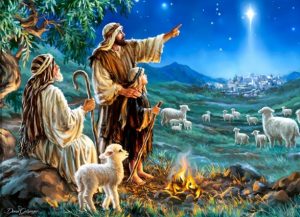by Rev. Antony W. Ball
Now in this same district there were shepherds out in the fields, keeping watch through the night over their flock, when suddenly there stood before them an angel of the Lord, and the splendour of the Lord shone round them. They were terror-stricken… Lk ii 8-10a NEB
.

I know I’m awkward, but I can’t help wondering what that shepherd is pointing to1. If you follow his finger, it might be that he’s pointing to the star, but the star is over Bethlehem, that village we can see a mile or so away in the distance, in which case we’d only see the shepherd’s back, surely?2 So it can only be that he’s pointing to ‘the angel of the Lord’, but do they all look ‘terror-stricken’ to you? My point is that scripture gives us just brief little word-pictures – we don’t really know what the stable into which Jesus was born looked like, any more than we know whether Jesus Himself was short or tall, fat or thin. Yet now we are living in a visual age – with not just films and television but CCTV, mobile phones which can take photographs, even door-bells which can incorporate cameras and cyclists with cameras built into their crash-helmets – when we’re out-and-about we never know who might be watching us.
This is something we should bear in mind when we’re reading scripture. We probably have our own mental pictures of the Christmas story, as it is told in the Gospels of Matthew and Luke and as it is depicted in paintings and on Christmas cards. We are shown Joseph walking, leading a donkey3 on which the Virgin Mary is seated, usually immaculate in her pristine clothing. They arrive at Bethlehem “…and while they were there they time came for her baby to be born”4 and she “…laid Him in a manger, because there was no room for them to lodge in the house”5. Luke gives no indication of how long they were in Bethlehem before Jesus’ birth – maybe days or even weeks? Only Luke mentions the ‘manger’ and the ‘no room at the inn’ details which become so significant in Christmas cards and Christmas carols, but get no more than a passing mention in scripture.
Such visual assumptions continue throughout scripture. For example, we’re shown the three ‘kings’ – whom only Matthew mentions6 – often dressed in their coronation robes which would not be exactly appropriate for an international journeys on camels.
So when we read the scriptures, let’s remember both that they were written in foreign languages which have to be translated into English for us and that they give us word-pictures which artists help us to visualize. Both translators and artists usually do their best, no doubt, but sometimes get things wrong.
.
1 I’m sorry to end a sentence with a preposition, but “what it is to which the shepherd is pointing” sounded too clumsy.
2 And don’t get me started on that sweet, spotlessly-clean, fluffy little lamb in the foreground which obviously doesn’t mind being separated from its mother, or mind being so near a fire; or on the shepherd-boy’s bare feet.
3 No donkey is mentioned in either Gospel – artists just assume that a pregnant woman could not walk the seventy miles or so from Nazareth to Bethlehem.
4 Lk ii 6 NEB
5 Lk ii 7b NEB
6 Mt ii 1-12 – the ‘three wise men’ of the old AV, occasionally promoted to be ‘kings’ in carols, were more likely to be astrologers or philosophers.